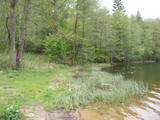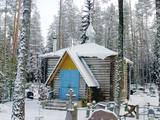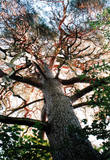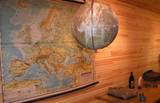| Нo | Название | Описание |
|---|---|---|
|
Overgrown with reeds, full of seashore meadows, lagoons, muddy little lakes and sandy shallows – this is the part of the Bay of Rīga shoreline which runs between Ainaži and Kuiviži. The Randi meadows are an important location for birds and plant life. It is a protected habitat with environmental restrictions. A bird-watching tower and nature trail have been installed so that visitors can study the meadows. The tour will take around one hour to complete. Objects are in the Northern Vidzeme Biosphere Reserve.
|
||
|
Латыши живут в тесной связи с природой и ее годичными циклами. Старинные знания о том, как использовть дары природы, до сих пор живы. Сбор диких грибов и ягод очень популярен,так же, как и сбор трав и цветов для чаев и настоек. Этот маршрут пытается показать вам различные пути использования природных ресурсов. Маршрут ведет в Национальный парк Кемери, богатый флорой, и интересный своими серными источниками, чья вода используется для улучшения проблем, связанных со здоровьем. Затем вы сможете посетить ферму, которая специализируется на травах и чаях, и чья владелица с готовностью поделится своими знаниями о растениях и как они могут быть использованы. А далее вас ждет осмотр достопримечательностей в живописной Кулдиге и уха на костре на побережье в Павилосте. На следующий день по плану – небольшая поездка по реке в традиционной рыбацкой лодке и поездка, где научитесь готовить блюда, используя природные дары. Экскурсия по Лиепае с ее пляжем из белого песка и исключительным военным наследием. Ночь в Природном заповеднике Папе. Возможность половить рыбу в озере и узнать о традиционных методах копчения рыбы. Посетите традиционный дом в Руцаве, где сможете ощутить и увидеть старинную культуру, а также отведать традиционные блюда. Затем отправляйтесь к производителю грибов шитаки и попробуйте их на вкус. Затем визит к произоводителям травяных чаев. Экскурсия к воспроизведенному семигальскому замку. На следующий день вас ждет поход в лес за грибами и их приготовление. Днем – визит к производителю продуктов из березового сока, где вы можете научиться собирать сок с берез и попробовать как сок, так и искристое вино. Затем возвращение в Ригу. |
||
|
The most important aspect of the Sasaļi forest is the eutrophic Lake Sasalis, as well as the unusual Lake Melnezers. Also of importance are various types of forestland in the area. Lake Sasalis is a popular place for leisure and swimming.
|
||
|
Популярное кафе в центре Сигулды – напротив железнодорожного вокзала. Предлагают завтраки, салаты, закуски, основные блюда. Натуральные, вкусные кондитерские и кулинарные изделия. |
||
|
Manufacture of sausages and smoked pigs. For pig feed, the farm uses home-grown grains (not treated with glyphosates) and unmodified soybeans grown by the farm itself. Sausages and smoked meat and spices. Only natural alder firewood is used in the smoking process. |
||
|
Пасечник обслуживает примерно 300 пчелиных семей, собранный с которых мед награжден во всевозможных номинациях. Мед борщевика, местные ягоды с медом и медовая соломка для детей (единственное место в Латвии). Интересующиеся могут отправиться на экскурсию по пасеке, попробовать (10 видов меда) и приобрести продукцию пчеловодства. «Экстремальный сбор меда» - во время которого следует надеть наряд пасечника, чтобы поближе познакомиться с трудолюбивыми насекомыми. Литье восковых свечей. |
||
|
В хозяйстве можно увидеть редко выращиваемых в Латвии ангорских кроликов. Предлагают экскурсию с рассказом, шерсть кроликов, шерстяные изделия (перчатки, носки), племенных кроликов и консультации. Дети могут познакомиться с животными и покормить их под присмотром хозяйки. |
||
|
Преемник ливов, лесник Эдгар Хаусманис обустроил музей найденных в лесу рогов (более 600 экспонатов). |
||
|
Uz pāļiem veidotā koku laipu taka līkumo cauri Vēršupītes dumbrājiem (pārmitri platlapju meži), tādēļ visiespaidīgākie skati šeit ir vērojami tieši pavasara palos vai citos gadalaikos pēc lielām lietavām, kad mazā upīte iziet no krastiem un appludina dumbrājus lielākā platībā. Par teritorijas sezonālu applūšanu liecina arī daudzo alkšņu resnie sakņu kakli, kas nevilšus atgādina mangrovju audzes. Mitrie meži ir viens no sugu skaita ziņā daudzveidīgākajiem Latvijas biotopiem.
|
||
|
An important complex of the coastline and its sand dunes along with the mouths of three major rivers – the Lielupe, the Daugava and the Gauja. This area has ancient traditions of recreation and spa services. The territory has lovely shoreline landscapes and features one of the few coastline meadows in Latvia. The nature park includes several restricted areas – the meadows of the Lielupe estuary, Vakarbuļļi, Daugavgrīva, Vecdaugava and Ummis (see the section on “Restricted Natural Areas”). Interesting elements of nature in this area include the amphitheatre of the Garciems dunes, along with individual dunes such as the Legzdiņi dune and the so-called ski mountain dune. Visitors will be attracted by various cultural and historical monuments – fortifications on the Mangaļi peninsula, military buildings from the period of the Russian tsars all the way through the late period of the Soviet occupation, the fortress of Daugavgrīva, the Vecāķi spa with its old shoreline buildings, and the beaches at Daugavgrīva and Vecāķi. The proximity of the city of Rīga and various important recreational resources are the reason for the massive anthropogenic burden that is placed on this territory. The nature park is appropriate for active tourism (hiking, bicycling, boating, driving), distance skiing, nature and bird-watching, cultural tourism, passive leisure and educational tourism. There are nature trails at Daugavgrīva and the Rožu dunes, along with other elements of infrastructure. |
||
|
Малтская (Розентовская) православная церковь Всех
Святых построена в 1928 году. Рубленая деревянная постройка
с двойными оконными рамами и куполом-луковицей, фасад –
стилизованный солнечный мотив.
|
||
|
Расположен около Резекненской окружной дороги (A12). Хозяйка готовит латгальские блюда, используя местные продукты. Сотрудничают с местными крестьянами и рыбаками. Латышская кухня: Крестьянский завтрак, слойка из черного хлеба с селедкой, ломоть черного хлеба с шпротами, картофель с соусом из лисичек, черничный суп с клецками, печеные яблоки, десерт из ревеня. Особое блюдо: Щука с копченой грудинкой в зеленом соусе. |
||
|
This is Latvia’s thickest common pine (Pinus slyvestris)
|
||
|
В основанном в 1982-ом году музее можно познакомиться с жизнью и бытом данного региона начиная со второй половины 19-го века до недавнего прошлого. В парках на 17 га музейной территории можно увидеть 200 различных видов деревьев и кустарников. Можно поучаствовать в различных тематических днях- испечь хлеб или познакомиться с датами Эстонского народного календаря. Из музея можно попасть на природную и культурологическую учебную тропу Велизе. |
||
|
The “Zoltners” restaurant offers dainty dishes from fresh seasonal products. The key philosophy of the menu is staying natural and unsophisticated. Endijs Vīnerts, the restaurant chef, has a special approach to create the combinations of tastes that are characteristic to North Europe and to discover new nuances of the tastes of local products. |
||
|
Iespaidīga koka celtne un izcils koka arhitektūras piemērs, kuru pamanīs katrs Plateļu apmeklētājs! Plateļu baznīca ir viens no Lietuvas vecākajiem koka dievnamiem. Pašreiz redzamais ir būvēts 1744. g., bet zvanu tornis – 1899. g. Dienvidos no baznīcas plešas Plateļu muižas parks. |
||
|
Pirts rituāli, zāļu tējas, izglītojoša pastaiga dabā, siena viesnīca. |
||
|
Расположена в центре Кандавы недалеко от Рыночной площади. Печенье, пирожные, торты, скландрауши, пирожки и др. |
||
|
Linezera dabas takā apskatāms ezers, kurš mēdz pazust pazemē. Apmeklējums saskaņojams ar zemes īpašnieku. |
||
|
Since 1820 people have been brewing Estonian beer here using local ingredients, like groundwater, yeast and others. The Saku Brewhouse name comes from the previous brewery that worked until 1992. The brewhouse also has a museum where you can see beer production from centuries ago until this very day. During the tour it is possible to taste freshly made beer. Minors are not allowed to participate in the tour. |
||




















